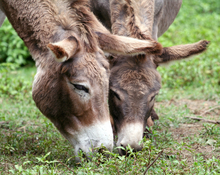According to Habitat for Horses, a stray Mexican donkey has tested positive for Glanders according to the Texas Animal Health Commission (TAHC).

Stray donkeys
The protocol for equine captured straying into Texas from Mexico is to test them for a number of diseases foreign to the U.S., including Glanders.
A USDA mounted quarantine enforcement inspector recently apprehended five Mexican stray donkeys along the Mexico-Texas border north of Presidio. The donkeys were transported to the USDA Presidio holding pens where they were isolated from contact with other animals. One of the five donkeys subsequently tested positive for Glanders.
Glanders causes respiratory infection and skin lesions in horses and humans. The disease is spread through close contact with other horses and by contaminated objects, such as brushes and tack.
The protocol for equine captured straying into Texas from Mexico is to test them for a number of diseases foreign to the U.S., including Glanders.
Glanders is a highly contagious, bacterial disease of the equine family. The disease is characterized by the development of ulcerating growths that are most commonly found in the upper respiratory tract, lungs, and skin. Infections are usually fatal. Humans and other animals are also susceptible.
âIt is imperative that we remain vigilant in protecting our borders from disease intrusions such as Glanders,â Dr. Dee Ellis, State Veterinarian and TAHC Executive Director. âMexican strays continue to pose a huge threat to Texas livestock and to our animal agriculture industry.â
The TAHC is working closely with USDA personnel in monitoring the situation along the border, and protecting Texas from possible disease threats. âEarly detection of Glanders and the immediate quarantine of these donkeys was critical in preventing and protecting against the spread of this foreign disease,â Ellis said.
The disease is commonly contracted by consuming food or water contaminated by the nasal discharge of carrier animals. The organism can survive in a contaminated area for more than one year, particularly under humid, wet conditions.
There is no vaccine for Glanders. Prevention and control depend on early detection and the elimination of affected animals, as well as complete quarantine.
Glanders was once prevalent worldwide, but has been eradicated or effectively controlled in many countries, including the United States. The last naturally occurring equine case in the U.S. was in 1942.
Founded in 1893, the Texas Animal Health Commission works to protect the health of all Texas livestock, including: cattle, swine, poultry, sheep, goats, equine animals, and exotic livestock.
